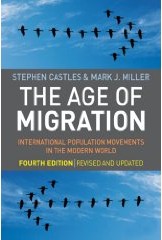August 20, 2009
Written by C.N.
New Book: The Age of Migration
As part of this blog’s mission of making academic research and data more easily accessible, understandable, and applicable to a wider audience and to practical, everyday social issues, I highlight new sociological books about Asian Americans and other racial/ethnic groups as I hear about them. As always, please remember that I highlight them for informational purposes only and do not necessarily endorse their entire content or arguments.
The Age of Migration: International Population Movements in the Modern World, by Stephen Castles and Mark J. Miller (The Guilford Press)

This incisive, authoritative work offers a global perspective on the nature of migration flows, why they take place, and their consequences for states and societies around the world. Chapters provide up-to-date descriptions and comparative analyses of major migration regions in the North and South. The role of population movements in the formation of ethnic minority groups is examined, as is the impact of growing ethnic diversity on economies, cultures, and political institutions. User-friendly features include accessible boxed examples, tables, and maps.
New to This Edition: Fully revised and expanded with current information and analysis; New chapters on development and on security; Covers national and international policy developments; Incorporates new approaches, such as transnational theory; The companion website features an online-only chapter, additional case studies, migration studies links, and periodic updates.
The Migration Policy Institute has a sample chapter from the book, titled “Migration in the Asia-Pacific Region,” which gives a nice summary of recent migration trends inside of Asian-Pacific countries (as opposed to immigration of Asians to countries outside of Asia):
Since the 1990s, migration within Asia has grown, particularly from less-developed countries with massive labor surpluses to fast-growing newly industrializing countries.
Indeed, all countries Asia experience both emigration and immigration — and often transit migration. But it is possible to differentiate between mainly destination countries (Brunei, Hong Kong, Japan, Singapore, South Korea, Taiwan), countries with both significant immigration and emigration (Malaysia and Thailand), and mainly source countries (Bangladesh, Burma, Cambodia, China, India, Indonesia, Laos, Nepal, Pakistan, Philippines, Sri Lanka, and Vietnam).
Migration agents and labor brokers organize most recruitment of Asian migrant workers both to the gulf and within Asia. . . . Asian governments seek to strictly control migration, and migrants’ rights are often very limited. Policymakers encourage temporary labor migration but generally prohibit family reunion and permanent settlement. While most migration in the region is temporary, trends toward long-term stay are becoming evident in some places.
The sample chapter on migration within Asian-Pacific countries is quite informative and also provides a very interesting contrast with immigration (legal and undocumented) to the United States. As the chapter describes, in almost all ways, immigrants to the U.S. experience a much easier and prosperous experience than migrants within Asia.
I suppose that’s why so many people around the world want to immigrate to the U.S. and will try to do so through whatever means possible to make a new life for themselves and their family.

